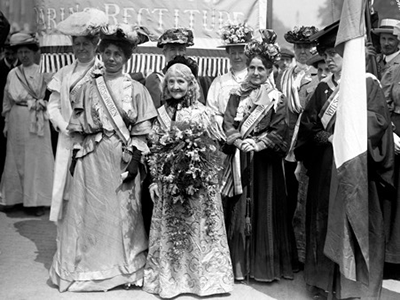Elizabeth was ‘a tiny Jenny-wren of a woman, with bright bird-like eyes, and a little face, child-like in its merriment …’ (Sylvia Pankhurst: 1931)
Welcome to my first post about Elizabeth Wolstenholme Elmy, truly a feisty feminist who laid the foundations upon which many of our laws today are built. Over the months I hope you will enjoy joining me as I open up the various aspects of her work and of those who worked alongside her. Let’s start by taking a quick overview of what she achieved as she worked tirelessly to create a society where women were free and equal with men, able to choose how they lived their lives and free from violence endorsed by the laws of the country.
Today in Britain, unless subject to any legal incapacity, adults can: vote, keep money we earn, gain an education and choose how to live (be single, married, live with a partner or any other option that suits us). In the Victorian period such rights, and many more, were denied to half the population. In fact, one half of the population had few legal rights and was generally regarded as belonging to their father, husband or a male guardian. Women’s rights had to be fought for and Elizabeth Wolstenholme Elmy was the woman to lead the way.
Let me introduce Elizabeth, a Manchester girl who studied at Fulneck Moravian School, near Leeds. After her two years at school she worked as a governess: she went on to teach in Manchester before setting up a school in Congleton, where she lived most of her life. From a very early age she questioned and challenged inequalities, showing her intelligence and the strong will that sustained her as she dedicated her efforts to embedding women’s rights in law.
A passionate feminist? There are very many definitions of feminist: I suspect that Elizabeth would have agreed with Margaret Atwood. Atwood’s view is that women are complete, equal and flawed. Certainly, Elizabeth was challenged by others who disagreed with her views on marriage, religion and many other topics. However, she was true to her beliefs and was supported by her lifelong partner, Ben Elmy: together they worked in various ways for what they saw as a better society that upheld human rights.
Feisty? Some can regard this as negative. However, in this context I am using the positive meaning of a person who is physically small and big in courage. Certainly, Elizabeth was prepared to be outspoken, to go against the norms of society and, as illustrated above in the quote from Sylvia Pankhurst, she was diminutive in stature.
For over fifty years she guided tirelessly the cause of women’s rights: her campaigns for social, legal and political equality shaped many of our rights and laws today. Today, laws in this country allow women to live independently and follow educational, personal and career goals. These are some of the many freedoms that were denied Victorian women. Elizabeth and many others fought for the freedoms that we may be tempted to take for granted.
To take on such a challenge demanded courage, strong opinions and a willingness to question accepted norms. These were characteristics that Elizabeth possessed. In addition, she was able to write in a way that both engaged and informed the reader; she certainly understood the power of the pen and regularly put it to good use in producing articles for journals and newspapers, plus a vast number of letters to politicians and many others involved in the various campaigns she pursued over the years.
It is unlikely that there was an MP from 1860 to just before World War One who did not get a letter from her or was not harangued in the entrance of Westminster if he opposed women’s rights. She knew how to collect around her those who shared her views, to build strong networks of people dedicated to women’s rights and to take on the many for whom the whole idea was abhorrent. Unlike many Victorian women, she had the courage to speak in public and to ‘say it as she saw it.’
Elizabeth was small in stature, but she packed a punch. Her energy seemed endless, and no topic was too difficult for her to tackle.
I hope you have enjoyed this brief introduction to Elizabeth. Please join me in future to hear more about the topics she tackled and the campaigns she took on, from improving girls’ education to the vote for women. Next time I will look at how growing up in Manchester in the 1830s and her young life influenced her views and gave her the passion to pursue her life as she wished to live.
In the meantime, please get in touch as I would like to hear your comments, views and questions.
Mary Holmes
The photograph above, which appeared in The Guardian, shows Elizabeth much later in her life. It was originally taken in 1908 at one of the many suffragette rallies she attended, it shows that Elizabeth was small in stature but she was certainly huge in impact. By this time Elizabeth had influenced many laws relating to women’s rights and was recognised by the Pankhursts and others as having laid the foundation for the suffrage movement.


Recent Comments